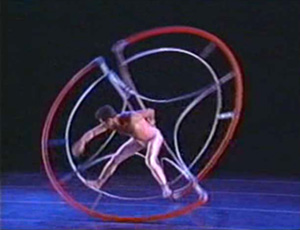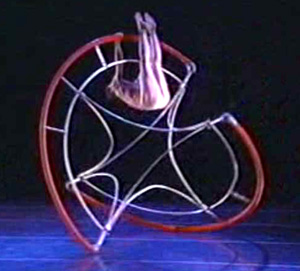1.) Exploring the Connections Between Bodies and Machines

From the time that Descartes famously declared “I think, therefore I am,” Western cultures have tended to regard the body as separate from the mind. This separation has led to the development of an industrial model of the human being which treats the body as a machine and positions the mind as its operator. One of the most obvious examples of this model in popular culture is the fitness craze in which our bodies merge with the weight machines, and our muscles and bones are envisioned as a series of levers and pulleys, while the heart is seen as the central motor powering the body. Similarly, the health and beauty industry in America repeatedly exhorts us to “oil our joints” with a certain product, to “manage our hunger” with another, or to “fix” a malfunctioning part of our body with surgery. In fact, with the amazing advances of modern medicine, some people live with machines, such as a pacemaker, inside their bodies. As we complete the first decade of the twenty-first century -- a historical moment when an astonishing array of machines are implicated in our lives -- it might be wise to reflect on the relationship of machines to our bodies and of our bodies to machines.
Dances too can include movement that is machine-like, and/or can integrate the use of machines in their composition. Such dances may contest or celebrate the presence of machines in human life, and/or may extend or limit the body’s movement potential in various ways. Indeed, Michael Jackson’s 1973 song “Dancing Machine” is just one of many representations of the dancing body as a sleek and efficient machine. While there are many negative dimensions to this analogy, especially with regard to the social pressure to “control” our bodies (particularly our weight), there are some positive aspects as well. For instance, if we imagine lifting the leg in terms of a system of pulleys, where a weight drops down the back in order to raise the limb in front, we can physically realize a battement in which the pelvis stays even and the back of the leg lengthens through its natural extension. This is a classic image given to beginning dancers to keep them from lifting the hip in order to lift the leg. So too, imagining our limbs as pendulums can help us release into the full motion of a swinging arm or leg.
One of the crucial issues at the intersection of the human body and machines is the question of natural and artificial. While science fiction is filled with cyborg bodies, that are literally half human/ half machine creatures who can do amazing things, we tend to see dancers as “naturally” graceful. This is, of course, a misnomer, as most dancers train their bodies for many, many years in order to appear as if pirouetting on their toes was completely “natural.” Indeed, for a long time, dancers tried to execute movements in a way that looked “effortless,” and a measure of their skill was how well they were able to hide the physical labor involved in dancing. Recently, however, dancers have become interested in revealing that muscular effort to the audience. For instance, Elizabeth Streb chooses to highlight the physical prowess of her dancers, emphasizing their strength, daring and stamina by asking them to repeatedly engage in extreme feats. Sometimes people see Streb’s work as an exhibition of gymnastics, rather than as a dance. Her use of technology -- trampolines, or gymnastic equipment -- on which to stage her works, as well as her use of video projections in the background resists traditional definitions of beautiful dancing. And yet, because of her use of machines of various kinds, Streb also presents her audience with the possibility of seeing the incredibly graceful arch in a flying back flip over and over again.
Classroom Activities:
- Make a list of machines that extend or limit bodily possibilities,
- View the photos of the 1985 dance “Circlewalker” contained in Appendix A. Discuss the relationship between the human figure and the apparatus pictured. How would you characterize this relationship? Who seems to be leading the actions portrayed in these images, the man or the machine?
- View the video of “Circlewalker” by Alan Boeding (performed by Jim Cappelletti in 1998). See Appendix A for contextual information on this dance.
- Allow students to free write (10 minutes) their responses to the dance, asking them to pay particular attention to using descriptive verbs and adverbs. Depending on the level of the student writing, the teacher may or may not want to read the description of the dance included in the collected materials.
- Elicit discussion about the nature of the relationship between the dancer and the machine in this film. Discussion questions:
- Would you call this dance a duet? Why or why not?
- What does this particular sculpture do for the dancer? Is this a machine? Why, or why not?
- How does the movement of the dancer affect the sculpture and how does the sculpture affect the motion of the dancer?
- Is this choreography beautiful?
- Why is the dancer not wearing a shirt?
- Ask students to identify specific examples of ways in which the machine expands or limits the movement possibilities of the dancer.

Discussion Ideas:
- What is a machine?
- How do bodies relate to machines?
- In what ways can bodies be served by machines?
- Can the body or specific body parts be replaced by machines?
- In what ways might bodies be considered subservient to machines?
- What are some ways in which the body’s possibilities can be extended by machines?
- What are some ways in which the body partners with machines?
- Do machines assist or constrain the body’s possibilities?
- Is the body itself a machine?
- List and describe a number of machines used by people for various purposes.
- What is the function of the machine in American society?
- Describe movement patterns found in different types of machine use (repetitive patterns, designs in space, pathways, rhythmic attributes, movement qualities, etc.).
- Does gender play a role in the types of machines people use? Explain.
Assignment:
Ask students to observe people outside of class interacting with machines in interesting ways. Find three good examples, describe each one in a paragraph or two, and be prepared to discuss these observations by the next class meeting. Pose the same questions about those situations as we asked above about Circlewalker. Prepare to demonstrate three separate motions derived from those human/machine interactions in the next class session.

